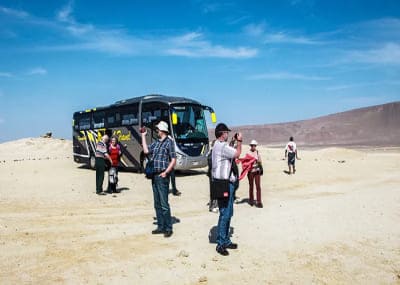Special Services in Paracas: Scientific Expeditions and Professional Filming
Paracas is not only a tourist destination for beaches, adventure, and marine wildlife. Its protected ecosystem, controlled access, and unique biodiversity have made it a privileged setting for scientific research, nature documentaries, and authorized filming projects. In this article, we’ll explore how Special Services in Paracas work and what opportunities they offer for institutions, production companies, or professional teams.
Why Is Paracas a Unique Natural Laboratory?
The Paracas National Reserve, protected by SERNANP (National Service of Natural Protected Areas of Peru), conserves one of the most diverse and fragile coastal-marine ecosystems in South America:
- Over 250 species of migratory and resident birds.
- Stable colonies of sea lions, dolphins, Humboldt penguins, and marine otters.
- Unique geological formations like red beaches, desert peninsulas, and sea cliffs.
- Archaeological zones related to the Paracas and Nazca cultures.
- Coastal flora adapted to hyper-arid desert environments.
This ecosystem, with low light pollution, minimal urbanization, constant winds, and stable microclimates, makes it ideal for:
- Marine and coastal biodiversity studies.
- Conservation programs and environmental monitoring.
- Wildlife filming (terrestrial, aerial, or underwater).
- International academic expeditions.
- Climate change simulations and desert zone studies.
Authorized Project Types in Special Services
SERNANP, together with specialized local operators like Turismo Náutico Paracas, manage permits and logistics for:
- Audiovisual productions: documentaries, nature series, films, professional photography, or high-end advertising.
- Scientific expeditions: universities, research centers, NGOs, marine biologists, ornithologists, or geologists.
- Technical operations: marine mapping, coastal surveys, soil analysis.
- Wildlife monitoring: observation of marine mammals, migratory birds, intertidal ecosystems, and submerged reefs.
🎥 Notable Documentary Productions Filmed in Paracas
- BBC: Planet Earth II (2016)
- NatGeo: Wild Peru
- Netflix: Our Great National Parks
- Discovery Channel and NHK Japan
- Smithsonian Institution scientific series
Paracas frequently appears as a key filming location due to its contrast between desert and ocean, large wildlife populations in their natural state, aerial visibility over geoglyphs like the Paracas Candelabra, and calm waters during certain seasons.
How Do Filming or Research Permits Work?
Any technical work in a protected area requires special permits. The process (which may take 10 to 30 days) includes:
- Formal application to SERNANP with a detailed technical project description.
- Environmental impact assessment for filming or scientific activity.
- Operational safety, rescue, and waste management plan.
- Assignment of local environmental supervisors.
Important Note: Without formal authorization, professional operations are fully prohibited, including drone flights, prolonged boat anchoring, or landings in restricted areas.
🔬 Logistical Services Provided by Turismo Náutico Paracas:
- Complete management of SERNANP permits.
- Authorized maritime transport for equipment and technical staff.
- Specialized boats with stable camera platforms.
- Marine safety and rescue equipment.
- Support from divers, certified local guides, and naturalists.
- Drone permits coordination for controlled zones.
- Logistics consulting for filming schedules or scientific sampling.
Why Is Paracas So Attractive for Filmmakers?
- Logistical proximity: just 3 hours from Lima with a nearby international airport (Pisco).
- Dry climate: almost 300 clear days a year for outdoor filming.
- Marine visibility: excellent for underwater shots with minimal currents.
- Dramatic topography: visual contrast of coastal desert and unique formations.
- High wildlife concentration: sightings close to shore without long journeys.
🚁 Drone Filming in Paracas: Extra Permits
Recreational drone use is highly restricted in the reserve, but authorized operators can manage technical flights in:
- The Paracas Candelabra
- Marine cliffs of the Reserve
- Sea lion colonies at Ballestas Islands (with regulated distance and height)
- Aerial filming of navigation scenes
💰 Cost Estimates (Small Projects)
- SERNANP Permit: from $250 to $1,500 depending on complexity.
- Maritime logistics services: from $500 per day.
- Technical support staff: $80–120 per day depending on roles.
- Mandatory environmental supervision: additional fee (assigned by the reserve).
Essential Prerequisites
- Detailed production plan.
- Active civil liability insurance.
- Schedule approved by the reserve.
- Maritime risk assessment if anchoring is included.
Final Conclusion
Paracas offers a world-class natural stage for professional marine wildlife productions, environmental research, and applied science. Its biodiversity, accessibility, authorized marine logistics, and safety standards make it a privileged destination for highly demanding technical work.
Want to produce world-class content or lead a scientific study in Paracas? We make it possible — from permits to full field operations.
Contact us to plan your professional project under official SERNANP regulations.


